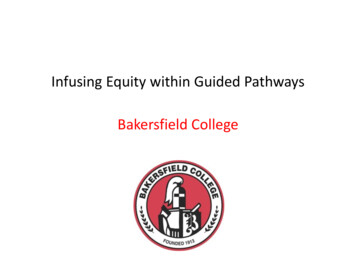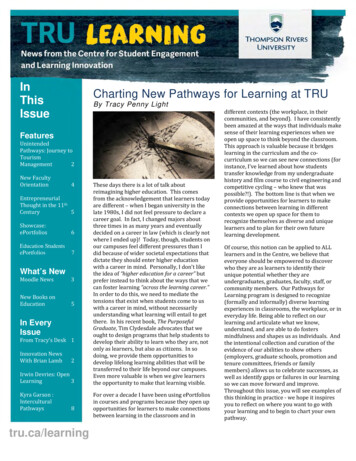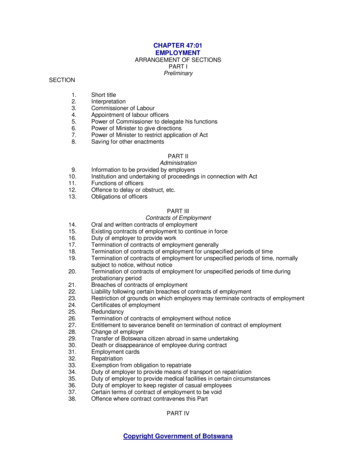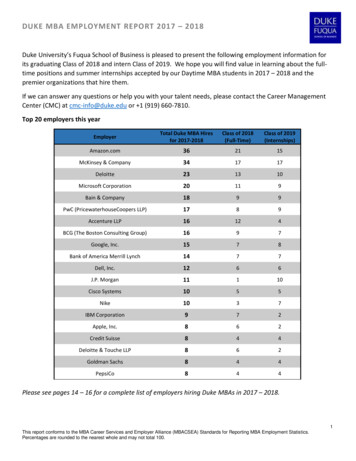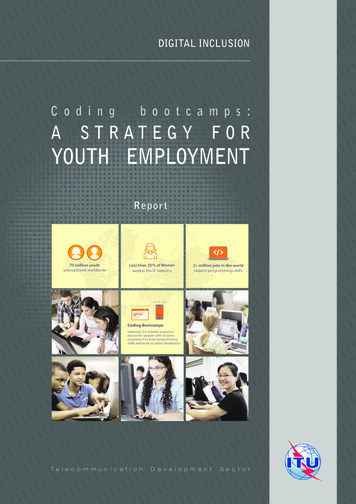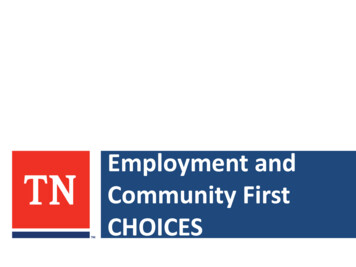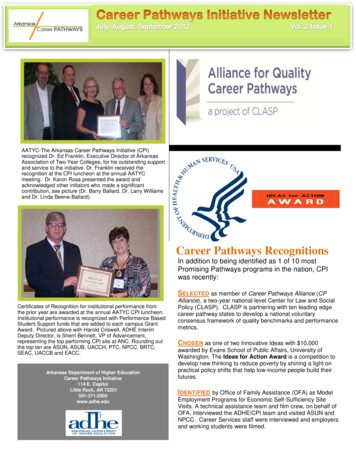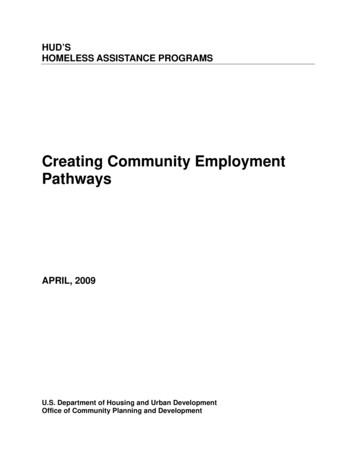
Transcription
HUD’SHOMELESS ASSISTANCE PROGRAMSCreating Community EmploymentPathwaysAPRIL, 2009U.S. Department of Housing and Urban DevelopmentOffice of Community Planning and Development
AcknowledgementsThis guidance material was prepared by ICF International under Grant VAMV-001-004 for theU.S. Department of Housing and Urban Development’s Office of Special Needs AssistancePrograms, Office of Community Planning and Development. This project was carried out inpartnership with Advocates for Human Potential.All materials in this work are in the public domain and may be reproduced or copied withoutpermission from U.S. Department of Housing and Urban Development. Citation of the source isappreciated. This publication may not be reproduced or distributed for a fee without the specificwritten authorization by the Office of Special Needs Assistance Programs, Office of CommunityPlanning and Development, U.S. Department of Housing and Urban Development.
CREATING COMMUNITY EMPLOYMENT PATHWAYSTable of ContentsChapter 1: Introduction .1Overview to the Guide .1Purpose of the Guide.2Target Audience .2What This Book Will Help You Do .3A Brief Introduction to Employment Services for People Who Are Homeless .3McKinney-Vento Programs .4Mainstream Workforce Programs.4Targeted Programs .5Partnerships for Success .6From Programs to Pathways .7How the Guidebook Is Organized.8Chapter 2: Preparing for Change .9Chapter 3: Researching Community Needs and Resources.9Chapter 4: Developing a Formal CEP Report .9Chapter 5: Implementing Action Steps from the CEP Report .9Chapter 6: Understanding the Needs of Homeless Jobseekers .10Chapter 7: Building Blocks for Community Employment Pathways .10Chapter 8: Conclusion.10Chapter 2: Preparing for Change .11Introduction.11What the Chapter Is About .11What the Reader May Expect to Gain from This Chapter .11Creating Community Employment Pathwaysi
Step 1: Build a Climate for Change .12Identifying Key Stakeholders.12Step 2: Build Linkages Between Service Providers and One-Stop Career Centers.16Step 3: Build a Structure for Change .23Being Inclusive .24Getting Buy-in.24Forming the Steering Committee .25Forming Workgroups.25Identifying a Boundary Spanner .26Convening a Community Leadership Group .26Step 4: Secure Funding and Resources for the CEP Initiative .27Estimate a Budget .27Possible Sources of Funding.28Step 5: Set Guidelines for the CEP Initiative .31Initial Tasks for the Steering Committee .32Adopting Exemplary Practices .36Worksheet 2.1: Convening Stakeholders .38Worksheet 2.2: Assessing the Relationship between Homeless Assistance and WorkforceDevelopment Systems – Where Is Your Community?.39Worksheet 2.3: Identifying Potential Change Agents .40Worksheet 2.4: Addressing Cultural Issues.41Chapter 3: Researching Community Needs and Resources .42Introduction .42What the Chapter Is About .42What the Reader May Expect to Gain from This Chapter .42Step 6: Research Your Labor Market .42Qualitative and Quantitative Research Methods .43Creating Community Employment Pathwaysii
Demand Side Research .44Supply Side Research.49Assessing Job Desirability and Accessibility .54Step 7: Learn the Services and Support Available to Homeless Jobseekers.55Identifying Employment Supports.56Determining Availability of Community Supports .59Evaluating Accessibility and Eligibility .60Step 8: Identify Funding Streams for Community Employment Pathways .61Housing Assistance System.61Workforce Development System.62“Braiding” Funding.62Influencing Workforce Planning Processes.63Step 9: Look for Models in Other Communities .64Worksheet 3.1: Questions for Demand Side Research .69Worksheet 3.2: Gathering Demographic Information .70Worksheet 3.3: Desirability/Accessibility Quadrant Chart.73Worksheet 3.4: Key Questions about Supports, Resources, and Services.74Chapter 4: Developing a Formal CEP Report .75Introduction.75What the Chapter Is About .75What the Reader Might Expect to Gain from This Chapter .75Step 10: Set the Stage for Action .75Provide Context for the Report.76Describe What You Discovered in the Field Research .78Step 11: Recommend Specific Action Steps .79Prioritizing Recommendations.81Creating Community Employment Pathwaysiii
Develop a Presentation .82Step 12: Mobilize Support for the Plan .83Plans to End or Reduce Homelessness.83Local Workforce Investment Plan.84Involving Government Agencies.85Media.86Worksheet 4.1: Expressing Workforce Development Goals.88Worksheet 4.2: Prioritizing Activities.89Chapter 5: Implementing Action Steps from the CEP Report.90Introduction.90What the Chapter Is About .90What the Reader Might Expect to Gain from This Chapter .90Pilot Projects.90Barriers to Effective Implementation.91Addressing Barriers .93Improving Working Relationships Among Stakeholders .94Maintaining Focus .95Involving New Voices .96Building a Case for Collaboration.97Finding Champions .97Supporting the Boundary Spanner .98Addressing Concerns about WIA Performance Measures.98Chapter 6: Understanding the Needs of Homeless Jobseekers.100Introduction.100What the Chapter Is About .100What the Reader May Expect to Gain from This Chapter .100Creating Community Employment Pathwaysiv
Homeless Subpopulations .100Experience of Homeless Jobseekers .102Underemployed and Unemployed.103Barriers to Employment.103Addressing Barriers to Services .104Worksheet 6.1: Homeless Subpopulations.107Worksheet 6.2: Experience of Homeless Jobseekers .108Chapter 7: Building Blocks for Community Employment Pathways .109Introduction .109What the Chapter Is About .109What the Reader May Expect to Gain from This Chapter .109Resources for Homeless Jobseekers .110Mainstream Services.111Targeted Programs .113Worksheet 7.1: Resources for Homeless Jobseekers – Mainstream Resources.116Worksheet 7.2: Resources for Homeless Jobseekers – Targeted Resources .119Chapter 8: Conclusion.120Introduction .120Keys to Collaboration.120Key Activities .122Transforming Organizational Relationships .122Under-promise and Over-deliver .122Reporting Progress .123Glossary of Terms .124Appendix 1: Sample Invitation to Bid .130Appendix 2: Sample Sources of Data .134Creating Community Employment Pathwaysv
Appendix 3: Sample Supportive Housing Provider Survey .135Appendix 4: Sample Outline for a Community Employment Pathways Report .142Creating Community Employment Pathwaysvi
CHAPTER 1: INTRODUCTIONOVERVIEW TO THE GUIDEMost people who are homeless are capable of working and want to work. This has been showntime and again from demonstration and research projects such as the Job Training for theHomeless Demonstration project, the Ending Chronic Homelessness through Employment andHousing project conducted by the U.S. Department of Labor (DOL), and the Next Step: Jobsinitiative conducted by the Corporation for Supportive Housing. These same projects have alsodemonstrated that the needs of homeless people require services across any number ofsystems and that obtaining a job alone does not equal economic stability for this population.1The housing, employment, and treatment systems are well formed into separate silos, generallywithout “bridges” for those who need to access services from multiple systems. For example,the majority of homeless assistance providers tend to focus on the most basic needs, likeshelter, medical care, and assistance with documentation and benefits. If they deal withemployment at all, it is to refer people to mainstream service providers such as One-StopCareer Centers. At the same time, while One-Stops and other mainstream vocational trainingand employment organizations are often tasked with serving special needs populations, theytypically do not track whether clients are homeless and do not refer people to other services likehealth care or housing. As a result, clients who are homeless may not be getting all of the helpthey need to obtain and maintain employment. The lack of collaboration and targeted programsleaves homeless people often crafting their own pathway through programs that are complexand, at times, contradictory.In order to improve outcomes for homeless jobseekers, systems can collaborate to create“Community Employment Pathways”—formalized and routine opportunities for training, jobplacement, and support. These pathways might take the form of referral procedures,relationships with industry sectors, or other mechanisms to help people who are homelesschoose, get, and keep jobs, regardless of which “door” they enter for assistance. The followingare all examples of pathways to employment: The local operator of One-Stop Career Centers opens a satellite branch at a homelessassistance agency. The local One-Stop stations staff at a homeless assistance agency one day a week. A homeless assistance agency brings clients as a group to look for jobs at the One-Stop,where a staff member is assigned to work with them. Local agencies collaborate with the hospitality industry to pre-screen, drug-test, andprovide uniforms and equipment to homeless jobseekers.1National Association of Mental Health Planning and Advisory Councils. (2003). Supported Employment:A guide for Mental Health Planning Advisory Councils. Rockville, MD: Substance Abuse and MentalHealth Services Administration. Additional information is available from the Employment InterventionDemonstration Program at the University of Illinois at Chicago, http://www.psych.uic.edu/eidp/Creating Community Employment Pathways1
Chapter 1: Introduction A permanent supportive housing program “vocationalizes” its building by adding a “jobsarea” with a computer and prominent job listings and by hiring tenants to work onsite.Creating Community Employment Pathways provides guidance to communities in leading aCommunity Employment Pathways (CEP) initiative. Although a CEP initiative is likely to be ledby a Continuum of Care (CoC) lead agency, it is a collaborative effort involving the workforcedevelopment and other systems. A CEP initiative has three primary goals: Increase the number of homeless and formerly homeless individuals in the workforce Expand access to existing employment services and expand investment of dollars frommultiple systems to address education and training needs of homeless jobseekers Improve critical cross-systems (housing, treatment services, and employment services)linkages so that homeless jobseekers have the needed housing, support, and training tobe successful.The agencies and individuals participatin
area” with a computer and prominent job listings and by hiring tenants to work onsite. Creating Community Employment Pathways. provides guidance to communities in leading a Community Employment Pathways (CEP)


